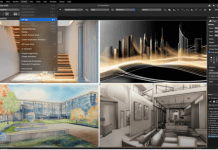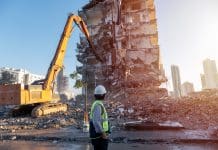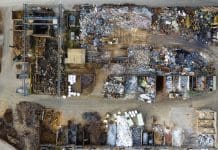Martin Huber, CEO and co-founder of 3D modelling and spatial data company Amrax, discusses how 3D visualisation can help construction firms embed deeper circularity
As businesses and industry come under pressure to step up their environmental efforts, it’s widely established that the circular economy offers a critical opportunity to conserve natural resources, limit waste and reduce emissions.
This becomes even more important in the context of the construction sector which is one of the largest generators of waste in the world.
It’s estimated that building and construction activities account for 40% of the world’s natural resources, generate 40% of waste, and emit 33% of the world’s emissions.
The sector is also the foremost user of raw materials, consuming roughly three billion tonnes globally.
The good news is that many countries have continued to significantly increase recycling of Construction Demolition Waste (CDW) thanks to a combination of landfill taxes and continual manufacturing innovation.
In the UK, for example, statistics show CDW recovery has hit 93.2%, which shows marked progress over time.
However, the reality is that there is still a significant volume of CDW that is not being recovered and is instead being dumped in landfills around the world.
Indicative of the scope for improvement, in the UK a recent report construction could reduce its emissions by two-thirds within 12 years solely by cutting use of raw materials – an opportunity that is likely similar in other countries.
3D visualisation and the circular opportunity
So, the big question is how can construction tackle its remaining waste problem and go full circle?
One emerging solution lies in the adoption of virtualisation as a way for the sector to more accurately conduct a pre-works or even pre-demolition assessment of viable recovery routes for solutions and materials that can be reused, recycled and recovered.
Of course, most construction professionals will already be well acquainted with the 3D visualisation concept. After all, Building Information Modelling (BIM) – the process of designing and managing a building throughout its lifecycle using a 3D equivalent of the building – has been in play now for a number of years.
Typically, this approach is adopted at the early design and construction stages, whereby all those in the supply chain, from architects and M&E consultants through to planners, designers and contractors are able to work from one single platform.
This means they can collaborate in real-time, detect clashes and avoid errors in order to keep projects on deadline, as well as within budget.
However, while much of the focus surrounding virtualisation via BIM appears to centre on a building’s planning and construction, some of its biggest benefits really come to light when in use in the retrofit setting – particularly in terms of the circular opportunity.
By using this platform, architects, engineers and construction professionals can better identify which parts can be reused in a new construction project or repurposed in other ways.
In this way, through digital identification such as QR codes, it becomes easier to track their origin, composition, product lifecycle and determine what can be salvaged or reused.
This approach can apply to everything from construction supplies and materials through to furniture and fixtures. It can also apply to the pre-demolition phase.
It may be, for example, an architect is able to determine the windows or doors in a desolate property can be easily slotted into a new build concept they are working on and brought back to life in a new way.
Another of virtualisation’s big benefits is the scope that it enables for collaboration. One of the major obstacles in the pathway to deeper circularity is construction’s tendency to work in silos.
Inherently, for each team, be it planners, engineers, builders or other contractors, the focus will be on getting the job done to a high standard as quickly and cost-effectively as possible. This can leave little scope for time to consider which materials and products can be used rather than sent to landfill. This is where virtualisation really comes in.
By enabling all teams to collaborate in real-time from the early planning stages, it becomes easier to collectively identify opportunities for improving resource efficiency and implementing circular construction principles.
As part of this, all the product information is available to all team members around the clock, ensuring work is streamlined and that there is full interoperability. This shared digital approach ensures that materials and resources are managed effectively through the entire process of a build as it happens, ensuring alignment of vision while maximising resource efficiency and reducing unnecessary wastage.
This knowledge can also prove invaluable in terms of validating the business case for sustainable options, particularly circular ones. In a traditional setup, for example, the inclination might be to use a standard product as the most cost-competitive option; chances being that it will, most likely, come with an extensive carbon footprint than a reusable product or other eco-alternative.
By enabling a holistic view into not only the visual performance but overall RoI of each option via data and analytics, however, the argument for investing in more sustainable options – including opportunities for repurposing – becomes more obvious and ‘sellable’.
Visualisation’s ongoing role
As a final point, once the initial works are done virtualisation can continue to play a huge role supporting ongoing circular economy strategy. For most building operators, of course, one of the biggest priorities at the moment will be reducing costs and emissions without compromising the overall functionality of a building.
By using 3D visualisation in conjunction with BIM, it becomes easier to track and proactively maintain and repair assets as required to extend their lifespan and reduce the need for replacements.
Better space management is a benefit, too. This is because it makes it easier for operators to gauge any underutilised areas that can be reused or better used, thus maximising the value of every inch of available space without the need for new construction or expansion.
Clearly, the transition to the circular economy model is essential to realising construction’s sustainability ambitions and net zero targets. While virtualisation is still very much an evolving concept in this arena, it is undoubtedly the future.
By taking stock now and being an early adopter of this groundbreaking opportunity to advance circularity, construction firms can stay one step ahead of a trajectory where it will be the survival of the greenest.
Martin Huber
CEO
Amrax














